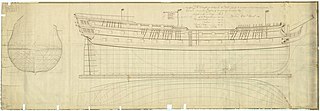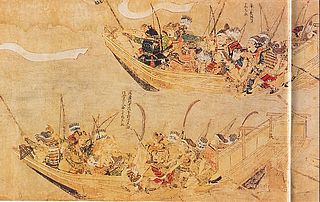
HMS Colossus was a 74-gun third-rate ship of the line of the Royal Navy. She was launched at Gravesend on 4 April 1787 and lost on 10 December 1798. During her years of service she participated in the Battle of Groix, the Battle of Cape St Vincent, and the Battle of the Nile. While carrying wounded from the latter, she was wrecked at the Isles of Scilly. The wreck is a Protected Wreck managed by Historic England.

Bun'ei (文永) was a Japanese era name after Kōchō and before Kenji. This period spanned the years from February 1264 to April 1275. The reigning emperor was Kameyama-tennō (亀山天皇).

Major military efforts were taken by Kublai Khan of the Yuan dynasty in 1274 and 1281 to conquer the Japanese archipelago after the submission of the Korean kingdom of Goryeo to vassaldom. Ultimately a failure, the invasion attempts are of macro-historical importance because they set a limit on Mongol expansion and rank as nation-defining events in the history of Japan. The invasions are referred to in many works of fiction and are the earliest events for which the word kamikaze is widely used, originating in reference to the two typhoons faced by the Yuan fleets.

The Battle of Kōan, also known as the Second Battle of Hakata Bay, was the second attempt by the Mongol-led Yuan dynasty of China to invade Japan after their failed attempt seven years earlier at the Battle of Bun'ei. In the summer of 1281, the Yuan invaded with two large armies. The Japanese defenders were aided by a major storm which sank a sizeable portion of the Yuan fleets. The invaders who reached the shore were repulsed shortly after landing. The Japanese called the opportune storm kamikaze, a name later used in the Second World War for pilots who carried out aerial suicide attacks.

The kamikaze were two winds or storms that are said to have saved Japan from two Mongol fleets under Kublai Khan. These fleets attacked Japan in 1274 and again in 1281. Due to the growth of Zen Buddhism among Samurai at the time, these were the first events where the typhoons were described as "divine wind" as much by their timing as by their force. Since Man'yōshū, the word kamikaze has been used as a Makurakotoba of waka introducing Ise Grand Shrine.

Association was a 90-gun second-rate ship of the line of the Royal Navy, launched at Portsmouth Dockyard in 1697. She served with distinction at the capture of Gibraltar, and was lost in 1707 by grounding on the Isles of Scilly in the greatest maritime disaster of the age. The wreck is a Protected Wreck managed by Historic England.

The Seven Stones reef is a rocky reef nearly 15 miles (24 km) west of Land's End, Cornwall and 7 miles (11 km) east-northeast of the Isles of Scilly. The reef consists of two groups of rocks and is nearly 2 miles (3.2 km) long and 1 mile (1.6 km) in breadth. They rise out of deep water and are a navigational hazard for shipping with 71 named wrecks and an estimated 200 shipwrecks overall. The most infamous is the Torrey Canyon in 1967, which was at that time the world's costliest shipping disaster and, to date, still the worst oil spill on the coast of the United Kingdom.

Kublai Khan, also known by his temple name as the Emperor Shizu of Yuan and his regnal name Setsen Khan, was the founder and first emperor of the Mongol-led Yuan dynasty of China. He proclaimed the dynastic name "Great Yuan" in 1271, and ruled Yuan China until his death in 1294.

The Scilly naval disaster of 1707 was the loss of four warships of a Royal Navy fleet off the Isles of Scilly in severe weather on 22 October 1707. Between 1,400 and 2,000 sailors lost their lives aboard the wrecked vessels, making the incident one of the worst maritime disasters in British naval history. The disaster has been attributed to a combination of factors, including the navigators' inability to accurately calculate their positions, errors in the available charts and pilot books, and inadequate compasses.
Richard James Vincent Larn, OBE is a retired Chief Petty Officer in the Royal Navy, a businessman and maritime history writer who is widely regarded as one of Britain's leading historic shipwreck experts.

Japan–Mongolia relations originally began in the 13th century between the Kamakura shogunate and the Mongol Empire, when the latter tried to conquer the former but failed. Formal diplomatic interactions were not established until the late 20th century.
 Kingdom of France) to London, England with a cargo of lampreys for King Henry III. [1]
Kingdom of France) to London, England with a cargo of lampreys for King Henry III. [1] 







